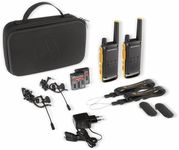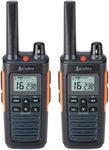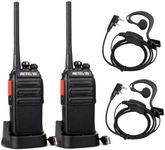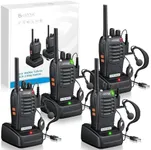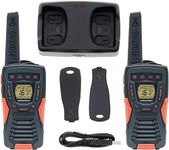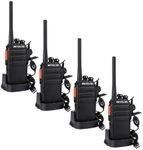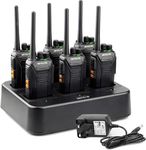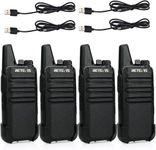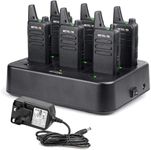Buying Guide for the Best Walkie Talkies
Walkie-talkies are a great tool for communication over short distances, whether you're hiking, camping, or working in a large facility. Choosing the right walkie-talkie involves understanding your specific needs and the environment in which you'll be using them. Consider factors like range, battery life, and durability to ensure you select a model that fits your requirements.RangeThe range of a walkie-talkie refers to the maximum distance over which it can effectively communicate. This is important because it determines how far apart you can be from the other person while still maintaining clear communication. Walkie-talkies typically have ranges from a few miles to several miles. If you're using them in open areas like fields or mountains, a longer range is beneficial. However, in urban environments or indoors, the range might be reduced due to obstacles like buildings. Consider your typical usage scenario to decide the range you need.
Battery LifeBattery life indicates how long a walkie-talkie can operate before needing a recharge or battery replacement. This is crucial for ensuring uninterrupted communication, especially during long outdoor activities or work shifts. Walkie-talkies can have rechargeable batteries or use disposable ones. If you plan to use them for extended periods, look for models with longer battery life or the option to carry spare batteries. For occasional use, shorter battery life might be sufficient.
DurabilityDurability refers to how well a walkie-talkie can withstand physical impacts, water exposure, and other environmental factors. This is important if you plan to use them in rugged conditions or outdoors. Walkie-talkies can be water-resistant or even waterproof, and some models are designed to be shockproof. If you're using them in harsh environments, opt for a more durable model. For casual use, a standard model might suffice.
ChannelsChannels are the different frequencies on which walkie-talkies can operate. Having multiple channels is important to avoid interference from other devices and to ensure privacy. Walkie-talkies can have anywhere from a few to several dozen channels. If you're using them in crowded areas or need secure communication, more channels can be beneficial. For simple communication needs, fewer channels might be adequate.
Privacy CodesPrivacy codes help prevent interference from other users on the same channel by filtering out unwanted transmissions. This is important for maintaining clear and private communication. Walkie-talkies can have various privacy codes, often in the form of CTCSS or DCS. If privacy is a concern, look for models with more privacy codes. For general use, fewer codes might be sufficient.
Size and WeightSize and weight refer to the physical dimensions and heaviness of the walkie-talkie. This is important for portability and ease of use, especially if you'll be carrying them for long periods. Walkie-talkies can range from compact and lightweight to larger and heavier models. If portability is a priority, opt for a smaller, lighter model. For stationary use or if size isn't a concern, larger models might be acceptable.


